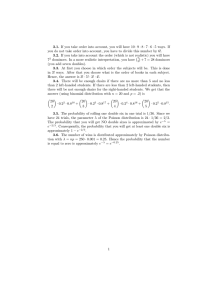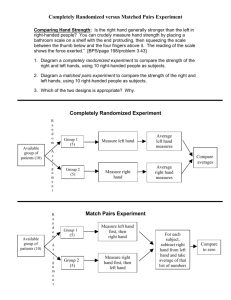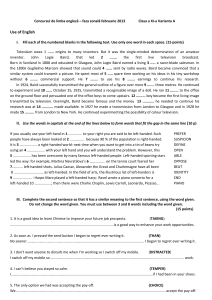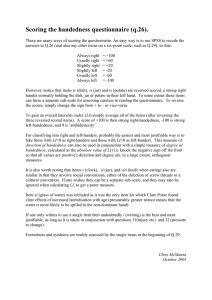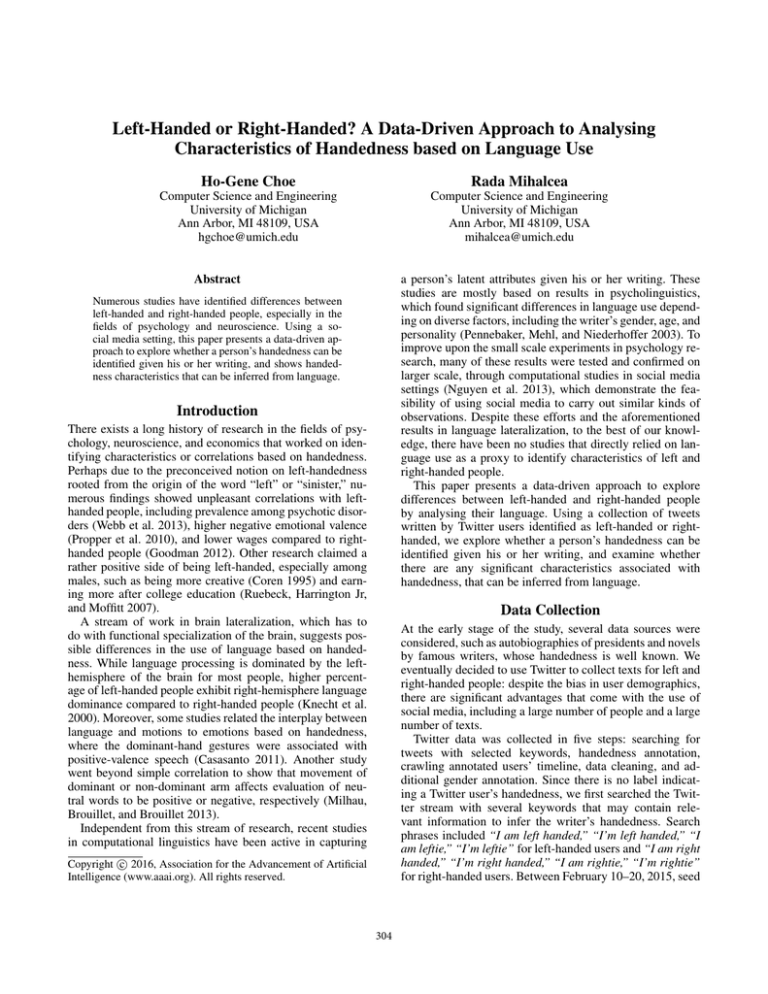
Left-Handed or Right-Handed? A Data-Driven Approach to Analysing
Characteristics of Handedness based on Language Use
Ho-Gene Choe
Rada Mihalcea
Computer Science and Engineering
University of Michigan
Ann Arbor, MI 48109, USA
hgchoe@umich.edu
Computer Science and Engineering
University of Michigan
Ann Arbor, MI 48109, USA
mihalcea@umich.edu
a person’s latent attributes given his or her writing. These
studies are mostly based on results in psycholinguistics,
which found significant differences in language use depending on diverse factors, including the writer’s gender, age, and
personality (Pennebaker, Mehl, and Niederhoffer 2003). To
improve upon the small scale experiments in psychology research, many of these results were tested and confirmed on
larger scale, through computational studies in social media
settings (Nguyen et al. 2013), which demonstrate the feasibility of using social media to carry out similar kinds of
observations. Despite these efforts and the aforementioned
results in language lateralization, to the best of our knowledge, there have been no studies that directly relied on language use as a proxy to identify characteristics of left and
right-handed people.
This paper presents a data-driven approach to explore
differences between left-handed and right-handed people
by analysing their language. Using a collection of tweets
written by Twitter users identified as left-handed or righthanded, we explore whether a person’s handedness can be
identified given his or her writing, and examine whether
there are any significant characteristics associated with
handedness, that can be inferred from language.
Abstract
Numerous studies have identified differences between
left-handed and right-handed people, especially in the
fields of psychology and neuroscience. Using a social media setting, this paper presents a data-driven approach to explore whether a person’s handedness can be
identified given his or her writing, and shows handedness characteristics that can be inferred from language.
Introduction
There exists a long history of research in the fields of psychology, neuroscience, and economics that worked on identifying characteristics or correlations based on handedness.
Perhaps due to the preconceived notion on left-handedness
rooted from the origin of the word “left” or “sinister,” numerous findings showed unpleasant correlations with lefthanded people, including prevalence among psychotic disorders (Webb et al. 2013), higher negative emotional valence
(Propper et al. 2010), and lower wages compared to righthanded people (Goodman 2012). Other research claimed a
rather positive side of being left-handed, especially among
males, such as being more creative (Coren 1995) and earning more after college education (Ruebeck, Harrington Jr,
and Moffitt 2007).
A stream of work in brain lateralization, which has to
do with functional specialization of the brain, suggests possible differences in the use of language based on handedness. While language processing is dominated by the lefthemisphere of the brain for most people, higher percentage of left-handed people exhibit right-hemisphere language
dominance compared to right-handed people (Knecht et al.
2000). Moreover, some studies related the interplay between
language and motions to emotions based on handedness,
where the dominant-hand gestures were associated with
positive-valence speech (Casasanto 2011). Another study
went beyond simple correlation to show that movement of
dominant or non-dominant arm affects evaluation of neutral words to be positive or negative, respectively (Milhau,
Brouillet, and Brouillet 2013).
Independent from this stream of research, recent studies
in computational linguistics have been active in capturing
Data Collection
At the early stage of the study, several data sources were
considered, such as autobiographies of presidents and novels
by famous writers, whose handedness is well known. We
eventually decided to use Twitter to collect texts for left and
right-handed people: despite the bias in user demographics,
there are significant advantages that come with the use of
social media, including a large number of people and a large
number of texts.
Twitter data was collected in five steps: searching for
tweets with selected keywords, handedness annotation,
crawling annotated users’ timeline, data cleaning, and additional gender annotation. Since there is no label indicating a Twitter user’s handedness, we first searched the Twitter stream with several keywords that may contain relevant information to infer the writer’s handedness. Search
phrases included “I am left handed,” “I’m left handed,” “I
am leftie,” “I’m leftie” for left-handed users and “I am right
handed,” “I’m right handed,” “I am rightie,” “I’m rightie”
for right-handed users. Between February 10–20, 2015, seed
c 2016, Association for the Advancement of Artificial
Copyright Intelligence (www.aaai.org). All rights reserved.
304
@username I’m a left handed pitcher ;) ⇒ Lefthanded (techincal: sports or musical instrument)
Left
Right
Male
104 (29%)
60 (29%)
Unknown
101 (28%)
58 (28%)
Total
358
205
Table 1: User Distribution
@username2 I’m right handed and I always keep my
phone in my left pocket and use my left hand for it. ⇒
Right-handed (minor/simple tasks)
hoffer 2003), but also to normalize possible differences in
lateralization based on gender (Tomasi and Volkow 2012).
As many Twitter users do not use their actual names for their
username, we manually visited each user’s timeline to annotate the gender if there is either one definitive evidence (e.g.,
explicitly identifying gender on their profile) or more than
one indirect evidence (e.g., repeated uploads of one person’s
selfie). Table 1 presents the user distribution in our dataset.
As shown in the table, despite all our efforts, the gender for
about 30% of the users could not be identified.
Throughout the following analyses, subsets of users were
randomly selected to balance the dataset. More specifically,
when performing analysis between left and right-handed
users as a whole (i.e., disregarding the gender label), 200
users from each class were randomly selected, and 300
tweets from each user were randomly chosen, resulting in
60000 tweets per each class. When performing gender-based
analysis, 60 male and 80 female users were randomly selected from each class, each with 300 randomly selected
tweets, resulting in 18000 male tweets and 24000 female
tweets per each class.2 We will refer to each dataset as All
dataset and Gender dataset, respectively.
I’m not left handed but I always draw myself left
handed ⇒ Ambidextrous (technical: drawing, writing)
I’m always that person that gets assigned to the left
handed desk during 2 hour exams :///// ⇒ Righthanded (inference)
Figure 1: Sample Decisions on Seed Tweets
tweets containing the aforementioned search phrases were
collected through the Twitter Search API.1
After obtaining the seed tweets, one of the authors manually verified the tweets and tagged each tweet’s user as one
of “left-handed,” “right-handed,” “ambidextrous,” or “cannot identify.” As handedness is defined as a continuous
rather than a discrete variable (e.g., strong right, weak left),
and is also dependent on the task at hand (e.g., write with left
hand, but throw with right), a set of decision rules were used
to tag each user consistently. Whenever possible, we tried
to identify each user’s dominant hand with the given information, ignoring uses of non-dominant hand for very simple
tasks, as shown in the top two examples in Figure 1. When
it was possible to identify that the user has a dominant hand
but uses non-dominant hand for technical activities such as
sports or drawing, the user was tagged as ambidextrous. Furthermore, when the user’s dominant hand could be inferred
from the tweet, it was used to tag the user as well.
Among these annotated users, tweets for users identified
as left-handed or right-handed (excluding ambidextrous)
were crawled through their timeline, starting from their most
recent tweet and excluding retweets. Since some users wrote
their tweets in more than one language, to restrict the analysis on English, users were selected for analysis only when
they wrote their tweets in English. To select these users, 300
tweets were sampled from each user and each tweet’s language was identified using the langid.py tool (Lui and
Baldwin 2012). A user was selected for analysis when more
than 75% of sampled tweets were identified as English.
Following previous work (Nguyen et al. 2013), we also
restricted the analysis to “typical” users, and removed users
with less than 300 tweets as well as users with more than
5000 followers. After this process, 358 left-handed users and
205 right-handed users were identified.
Additional gender annotations were also carried out for
the users identified above, not only to normalize linguistic
differences based on gender (Pennebaker, Mehl, and Nieder1
Female
153 (43%)
87 (42%)
Predicting Handedness
In order to explore whether the user’s dominant hand could
be identified from tweets, we first perform a classification
based on simple lexical features, including unigrams; length
of tweets; part-of-speech tags (Gimpel et al. 2011); word
classes based on Linguistic Inquiry and Word Count (LIWC)
(Pennebaker, Francis, and Booth 2001). Different preprocessing and feature selection mechanisms were tested, including stemming and chi-square feature selection. For evaluation, the classification performance was calculated by averaging test set accuracies during five-fold cross validation.
The classification is performed on two different levels of
granularity: tweet-level and user-level. During tweet-level
classification, although each tweet is treated as a single document, all tweets from a single user are ensured to be only in
either training or test set, so that user specific characteristics
are not used to boost the accuracy. Among several classifiers,
random forest and logistic regression performed the best depending on the level of granularity, where the parameters for
each classifier are learned through cross validation on the
training set (i.e., four-fold cross validation on the training
set for each run during the five-fold cross validation).3
Results are shown in Table 2, where separate classifications are performed on the All and Gender datasets. Although the accuracies are small, they are all significant with
2
Note that the tweets including the search phrases used to identify the handedness of the users are explicitly removed.
3
All the experiments are carried out using Python and scikitlearn (Pedregosa et al. 2011).
https://dev.twitter.com/rest/public/search
305
Dataset
Tweet-level
All
0.523***
Gender: Male
0.555***
Gender: Female
0.528***
Baseline
0.500
***p < 0.001, *p < 0.05
User-level
0.575*
0.642*
0.588*
0.500
observed that right-handed males have a higher usage of language related to negative emotions, compared to left-handed
males. Such observation is supported by the WordNet Affect
analysis in Table 4. In Table 3, note also that left-handed
males comparatively use more optimistic language.
Results for females are shown in the bottom part of Table
3. Compared to the results for males, fewer categories are
identified as significant in the results for females. Table 3
shows that right-handed females have a higher usage of language that refers to other people, compared to left-handed
females. No category in WordNet Affect is identified as significantly different for females.
Table 2: Classification Accuracy Results
respect to the baseline, which suggests that there are indeed
differences between the language used by left and righthanded people. While the user-level accuracies are higher
compared to the tweet-level, they have lower degree of significance, due to a drastically reduced number of instances
in the task (e.g., 60000 vs. 200 instances per class in case
of All). Also, note that in both cases a higher accuracy is
achieved for males.
In order to further ensure the significance of the results,
we compare the original accuracy with the accuracy that
could be obtained from classifying a random mix of users,
in which users are randomly labeled as one of two different
classes disregarding their handedness. This checks whether
similar accuracies could be achieved by capturing any arbitrary hidden characteristics of users in each class. Best average accuracies obtained from such settings were significantly lower, with absolute differences of at least 0.02 for
tweet-level and 0.05 for user-level as compared to the numbers reported in Table 2. This suggests that while it is difficult to predict a person’s handedness from the language,
there are some differentiating characteristics between left
and right-handed users.
Discussion
The classification results as well as the lexical-based analyses suggest possible differences between left-handed and
right-handed people based on their language use. There
seems to be more observable differences between males
than females, which is in line with previous work in psychology that found stronger effects associated with handedness among males (Coren 1995; Ruebeck, Harrington Jr,
and Moffitt 2007), and could possibly be explained by the
higher degree of brain lateralization among males (Tomasi
and Volkow 2012).
Across analyses, there is a strong association of negative
emotional categories with right-handed males and some association of positive emotional categories with left-handed
males. While it is difficult to concretely understand or explain this result, one speculation could be a possible emotional effect due to left-hand-oriented keyboard typing behaviors required for writing in online settings. In the dataset,
the count of characters that require left-hand typing are
about 10% higher than the count of characters that require
right-hand, and a previous work suggests a bias in evaluation
of neutral words to be positive or negative, depending on the
movement of dominant or non-dominant hand, respectively
(Milhau, Brouillet, and Brouillet 2013). While biased evaluation of neutral words does not directly account for using
emotional words, it may be possible that a positive feedback
mechanism is present to affect their language use. Experiments in constrained settings would be required to evaluate
this speculation and to explain the causality of this result.
Linguistic Analysis
We also perform a linguistic analysis to determine if there
are any characteristics of handedness that can be inferred
from language use. We use lexical-based methods, using the
LIWC (Pennebaker, Francis, and Booth 2001) and WordNet
Affect lexicons (Strapparava and Valitutti 2004). LIWC includes about 2300 word-stems grouped into 70 different categories related to psychological processes, and WordNet Affect includes about 1100 words grouped into 6 basic emotion
categories. For LIWC, as the lexicon contains both words
and word-stems (e.g., “fail*” to cover “fails,” “failed,” etc.),
word-stems were expanded to include all variations of such
stems during the analysis.
To examine the differences between the left-handed and
right-handed groups, a two-sample t-test was performed for
each category in the lexicons. Since left-handed users appear to write more words per tweet on average compared to
right-handed users (12.29 vs. 11.75 words per tweet), to normalize for the number of words, the percentage of categories
used per each user is calculated and used in the analysis. For
reasons of space, and since they are more insightful, we only
report linguistic analyses performed on the Gender dataset.
Analyses comparing left-handed males to right-handed
males are shown in the top part of Tables 3 and 4. Table 3
shows LIWC categories that had significant p-value in twosample t-test, in the increasing order of p-value. It can be
Conclusions
This paper presented a data-driven approach to explore
whether there are any differences between left-handed and
right-handed people in an online social media setting, as can
be observed from their language use. While there are several
limitations inherent to this study, most importantly having to
do with the bias present in the user sample (e.g., given that
users included in the study identified their handedness on the
web, it is possible that the user sample is biased in some personality dimensions, such as how easily one reveals oneself),
both the classification results and the lexical-based analyses
showed possible indications of linguistic differences based
on handedness, mostly in male users. Further experiments
and analyses are required to concretely evaluate and understand the findings in this study.
306
Category
Sample Words
NEGEMO
ANGER
SIMILES
SWEAR
OPTIM
NEGATE
SEXUAL
OTHREF
ARTICLE
YOU
Gender: Male
bad, hate, wrong, sorry, miss, crazy, lost, weird, sad
hate, damn, bitch, mad, stupid, kill, fight, dumb
like
shit, fuck, ass, damn, bitch, hell, dick, suck, piss
best, hope, win, free, top, ready, super, definitely, easy, won
not, don’t, no, can’t, never, didn’t, nothing, doesn’t, isn’t, won’t
love, fuck, dick, gay, sex, pussy, nude, hug, kiss
Gender: Female
you, your, he, they, we, she, her, them, someone, his
the, a, an
you, your, ya, y’all, yourself, yours, you’re, your, thee, thy
LH (Mean)
RH (Mean)
2.377
1.224
0.466
0.882
0.711
2.069
0.694
2.996
1.758
0.591
1.351
0.607
2.315
0.919
4.784
4.493
2.376
5.321
4.145
2.761
Table 3: LIWC Categories Used Differently by Left-handed (LH) and Right-handed (RH) Users (p-value < 0.05)
Category
Sample Words
ANGER
SADNESS
DISGUST
Gender: Male
hate, mad, annoying, score, fit, pissed, angry, bother, jealous, evil
down, bad, sorry, sad, bored, blue, dark, poor, low, weight
sick, foul, horror, offensive, disgusting, disgusted, wicked, disgust, sickening
LH (Mean)
RH (Mean)
0.222
0.339
0.034
0.299
0.403
0.056
Table 4: WordNet Affect Categories Used Differently by Left-handed (LH) and Right-handed (RH) Users (p-value < 0.05)
Acknowledgments
tion for Computational Linguistics 2012 system demonstrations, 25–30.
This material is based in part upon work supported by the
National Science Foundation (#1344257), the John Templeton Foundation (#48503), and the Jeongsong Cultural Foundation. Any opinions, findings, and conclusions or recommendations expressed in this material are those of the authors and do not necessarily reflect the views of the National
Science Foundation, the John Templeton Foundation, or the
Jeongsong Cultural Foundation.
Milhau, A.; Brouillet, T.; and Brouillet, D. 2013. Biases
in evaluation of neutral words due to motor compatibility
effect. Acta psychologica 144(2):243–249.
Nguyen, D.; Gravel, R.; Trieschnigg, D.; and Meder, T.
2013. “how old do you think i am?”; a study of language
and age in twitter. In Proceedings of the Seventh International AAAI Conference on Weblogs and Social Media.
AAAI Press.
References
Pedregosa, F.; Varoquaux, G.; Gramfort, A.; Michel, V.;
Thirion, B.; Grisel, O.; Blondel, M.; Prettenhofer, P.; Weiss,
R.; Dubourg, V.; Vanderplas, J.; Passos, A.; Cournapeau, D.;
Brucher, M.; Perrot, M.; and Duchesnay, E. 2011. Scikitlearn: Machine learning in Python. Journal of Machine
Learning Research 12:2825–2830.
Casasanto, D. 2011. Different bodies, different minds the
body specificity of language and thought. Current Directions in Psychological Science 20(6):378–383.
Coren, S. 1995. Differences in divergent thinking as a function of handedness and sex. The American journal of psychology 311–325.
Gimpel, K.; Schneider, N.; O’Connor, B.; Das, D.; Mills,
D.; Eisenstein, J.; Heilman, M.; Yogatama, D.; Flanigan, J.;
and Smith, N. A. 2011. Part-of-speech tagging for twitter:
Annotation, features, and experiments. In Proceedings of the
49th Annual Meeting of the Association for Computational
Linguistics, short papers, 42–47.
Goodman, J. 2012. The wages of sinistrality: Handedness,
brain structure and human capital accumulation.
Knecht, S.; Dräger, B.; Deppe, M.; Bobe, L.; Lohmann,
H.; Flöel, A.; Ringelstein, E.-B.; and Henningsen, H.
2000. Handedness and hemispheric language dominance in
healthy humans. Brain 123(12):2512–2518.
Lui, M., and Baldwin, T. 2012. langid. py: An off-the-shelf
language identification tool. In Proceedings of the Associa-
Pennebaker, J. W.; Francis, M. E.; and Booth, R. J. 2001.
Linguistic inquiry and word count: Liwc 2001. Mahway:
Lawrence Erlbaum Associates 71:2001.
Pennebaker, J. W.; Mehl, M. R.; and Niederhoffer, K. G.
2003. Psychological aspects of natural language use: Our
words, our selves. Annual review of psychology 54(1):547–
577.
Propper, R. E.; Brunyé, T. T.; Christman, S. D.; and Bologna,
J. 2010. Negative emotional valence is associated with nonright-handedness and increased imbalance of hemispheric
activation as measured by tympanic membrane temperature.
The Journal of nervous and mental disease 198(9):691–694.
Ruebeck, C. S.; Harrington Jr, J. E.; and Moffitt, R. 2007.
Handedness and earnings. Laterality 12(2):101–120.
307
Strapparava, C., and Valitutti, A. a. o. 2004. Wordnet affect: an affective extension of wordnet. In LREC, volume 4,
1083–1086.
Tomasi, D., and Volkow, N. D. 2012. Laterality patterns
of brain functional connectivity: gender effects. Cerebral
Cortex 22(6):1455–1462.
Webb, J. R.; Schroeder, M. I.; Chee, C.; Dial, D.; Hana, R.;
Jefee, H.; Mays, J.; and Molitor, P. 2013. Left-handedness
among a community sample of psychiatric outpatients suffering from mood and psychotic disorders. SAGE Open
3(4):2158244013503166.
308


